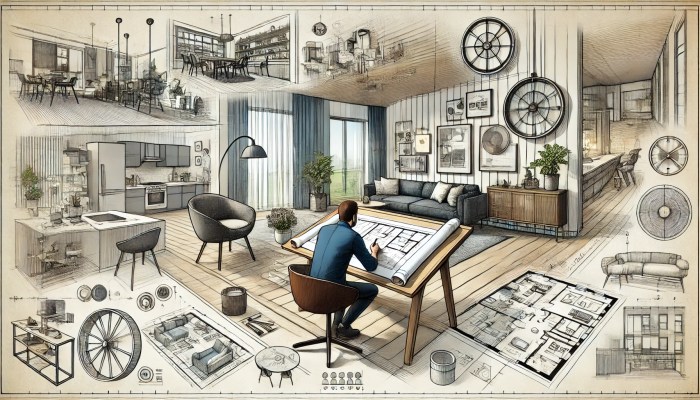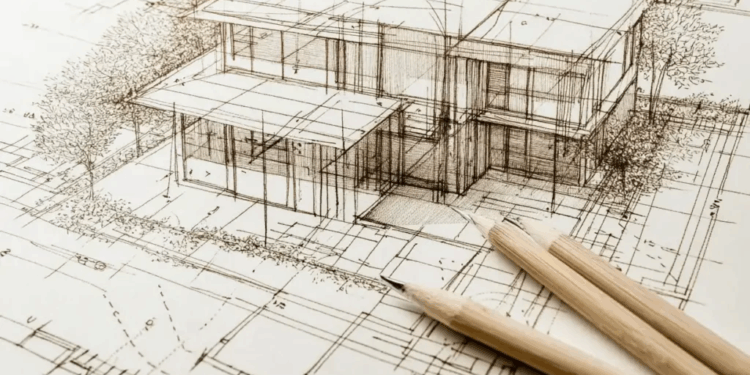
Delving into the realm of architecture and interior design, this piece unveils the intricacies and creativity behind the roles of architects and interior designers. Get ready to uncover a world where imagination meets functionality, shaping spaces and structures with finesse.
Overview of Architect and Interior Designer

An architect is responsible for designing and planning the construction of buildings and structures. They work on creating functional and aesthetically pleasing designs while considering safety regulations, building codes, and the needs of clients. Architects also oversee the construction process to ensure that the design is implemented correctly.Interior designers focus on creating interior spaces that are both functional and visually appealing.
They work with clients to understand their preferences and needs, and then develop design concepts for spaces such as homes, offices, and retail establishments. Interior designers select and arrange furniture, lighting, color schemes, and other elements to create cohesive and inviting interiors.
Roles and Responsibilities of an Architect
- Developing design concepts for buildings and structures
- Creating detailed drawings and specifications
- Collaborating with clients, engineers, and construction teams
- Ensuring compliance with building codes and regulations
- Overseeing construction progress and resolving any issues that arise
Duties and Tasks of an Interior Designer
- Meeting with clients to determine design preferences and requirements
- Developing design proposals and presenting them to clients
- Selecting furniture, fixtures, and materials for interior spaces
- Creating layout plans and 3D renderings of design concepts
- Coordinating with contractors and vendors to implement the design
Comparison of Architect and Interior Designer
| Architect | Interior Designer |
|---|---|
| Focuses on the design and construction of buildings | Focuses on the design of interior spaces |
| Considers structural integrity and building codes | Emphasizes aesthetics and functionality |
| Oversees the entire construction process | Works on the interior design aspects of a space |
| Collaborates with engineers and construction teams | Collaborates with clients and contractors |
Education and Training

To become an architect, individuals typically need to complete a professional degree in architecture from a program accredited by the National Architectural Accrediting Board (NAAB). This can be a Bachelor of Architecture (B.Arch) or a Master of Architecture (M.Arch) degree.
In addition to the degree, aspiring architects must also complete a period of practical training through an internship or apprenticeship.
Educational Requirements for Architects
- Completion of a professional degree in architecture from an NAAB-accredited program
- Practical training through an internship or apprenticeship
- Passing the Architect Registration Examination (ARE) to become licensed
Training and Certifications for Interior Designers
Interior designers typically need a bachelor’s degree in interior design or a related field. They may also pursue certifications such as the National Council for Interior Design Qualification (NCIDQ) exam to demonstrate their expertise and credibility in the field.
- Bachelor’s degree in interior design or a related field
- Pursuing certifications like the NCIDQ exam
- Continuing education to stay updated on trends and innovations in interior design
Key Differences in Educational Paths
- Architects focus on the design and construction of buildings, requiring a professional degree in architecture and licensure.
- Interior designers specialize in creating functional and aesthetically pleasing interior spaces, with a focus on furniture, decor, and layout.
- Architects typically have a longer educational path with a professional degree, internship, and licensure requirements.
- Interior designers can enter the field with a bachelor’s degree but may pursue certifications for professional advancement.
Design Process
Architects and interior designers follow a systematic approach to design projects, ensuring a cohesive and functional outcome.
Architects Design Process
Architects typically follow a step-by-step process when working on a project:
- Programming: Understanding the client’s needs, project goals, and constraints.
- Schematic Design: Developing initial design concepts and ideas.
- Design Development: Refining the chosen concept, developing detailed drawings and specifications.
- Construction Documents: Creating detailed plans for construction, including technical specifications.
- Bidding and Negotiation: Assisting the client in selecting a contractor and negotiating the construction contract.
- Construction Administration: Overseeing the construction process to ensure the design intent is carried out.
Interior Designers Design Process
Interior designers also follow a systematic approach when working on a project:
- Initial Consultation: Meeting with the client to understand their needs, style preferences, and budget.
- Concept Development: Creating a design concept that reflects the client’s requirements and aesthetic preferences.
- Space Planning: Developing layout options to optimize the use of space and flow within the interior.
- Selection of Materials and Finishes: Choosing materials, colors, and finishes that align with the design concept.
- Furniture and Fixture Selection: Selecting furniture, lighting, and accessories to complement the design.
- Installation and Styling: Managing the installation of the design elements and adding final touches to complete the space.
Collaboration between Architects and Interior Designers
Architects and interior designers often collaborate during the design process to create a cohesive and harmonious space:
- Communication: Regular communication between architects and interior designers ensures that the architectural and interior elements complement each other.
- Coordination: Coordination in the selection of materials, finishes, and overall design aesthetic helps in achieving a unified vision.
- Integration: Integrating architectural features with interior design elements creates a seamless and functional space.
Skills and Qualities
In the field of architecture and interior design, professionals require a specific set of skills and qualities to excel in their roles. Architects and interior designers both play crucial roles in creating functional and aesthetically pleasing spaces. Let’s explore the essential skills and key qualities needed for success in these professions.
Skills for Architects
Architects need to possess a diverse range of technical and creative skills to design buildings that are structurally sound, visually appealing, and functional. Some essential skills for architects include:
- Proficiency in architectural software like AutoCAD and Revit
- Strong understanding of building codes and regulations
- Ability to visualize and conceptualize design ideas
- Excellent problem-solving and analytical skills
- Effective communication and collaboration skills
Qualities for Interior Designers
Successful interior designers possess a unique blend of creative flair, attention to detail, and client communication skills. Key qualities that make a successful interior designer include:
- Creativity and a keen eye for design aesthetics
- Strong sense of color, texture, and spatial awareness
- Excellent listening and communication skills to understand client needs
- Attention to detail and ability to work within budget constraints
- Adaptability and willingness to stay updated on design trends
Comparison of Skills
While architects and interior designers both require creativity and design skills, the focus and technical requirements of their roles differ. Architects need a strong understanding of structural principles and building technology, while interior designers focus more on aesthetics, functionality, and client needs.
Both professions require excellent communication skills, but architects may need more technical proficiency in software and building codes, whereas interior designers need a deeper understanding of design elements and client relationships.
Project Types
Architects and interior designers work on a wide range of projects, each requiring unique expertise and creativity. Let’s explore the different types of projects they typically handle.
Architects
- Residential Projects: Designing homes, apartments, or condominiums for individuals or families.
- Commercial Projects: Creating office buildings, retail spaces, restaurants, or hotels.
- Public Projects: Working on schools, hospitals, museums, or government buildings.
- Renovation Projects: Revamping existing structures to meet modern needs and standards.
- Landscape Projects: Designing outdoor spaces, parks, or gardens to enhance the environment.
Interior Designers
- Residential Interiors: Designing the layout, furniture, and decor of homes and apartments.
- Commercial Interiors: Planning the interiors of offices, stores, restaurants, or entertainment venues.
- Hospitality Projects: Creating welcoming environments for hotels, resorts, or spas.
- Healthcare Facilities: Designing interiors that promote healing and well-being in hospitals or clinics.
- Retail Spaces: Enhancing the shopping experience through strategic layout and design elements.
Unique Projects
Architects and interior designers often get the chance to work on extraordinary projects that showcase their talent and innovation. Examples include:
A futuristic eco-friendly community designed by architects using sustainable materials and renewable energy sources.
An interior designer transforming a historic building into a modern art gallery while preserving its original charm and character.
A collaborative project between architects and interior designers to create a wellness center that promotes physical and mental well-being through innovative design elements.
Final Thoughts
As we conclude this journey through the realms of architecture and interior design, we are left with a profound appreciation for the artistry and expertise that architects and interior designers bring to the table. From grand structures to intimate spaces, their collaborative efforts continue to shape the way we experience the world around us.
Key Questions Answered
What are the key differences between an architect and an interior designer?
Architects focus on the overall design and structure of a building, while interior designers specialize in creating functional and aesthetically pleasing interiors.
What educational requirements are needed to become an architect?
Architects typically need a professional degree in architecture and must complete a certain number of training hours to become licensed.
What skills are essential for architects?
Essential skills for architects include strong design abilities, technical proficiency, and project management expertise.
What projects do interior designers typically work on?
Interior designers can work on a variety of projects such as residential homes, commercial spaces, hospitality venues, and healthcare facilities.















